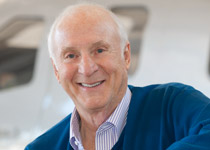
- From reader Jerry Griggs: What was the first pressurized, piston-powered, single-engine airplane produced in the United States?
- True or false? More pilots became aces flying the North American P-51 Mustang than any other U.S. fighter during World War II.
- From reader John Schmidt: Which one or more of the following countries operate one or more aircraft carriers?
- France
- India
- Italy
- Spain
- Thailand
- Who said the following? “Let’s get one thing straight. There’s a big difference between a pilot and an aviator. One is a technician, and the other is an artist in love with flight.”
- Frank Borman
- Howard Hughes
- Elrey Jeppesen
- Eddie Rickenbacker
- From reader George Shanks: Why did the U.S. Air Force require some of its pilots to be married during the Cold War?
- True or false? Orville Wright was the first pilot to fly a complete circle in an airplane.
- What were the first weapons used by pilots of the first Allied fighter planes of World War I?
- The Canadian-built robotic arm, Canadarm2, on the International Space Station weighs almost two tons. Why does it need to be so strong and heavy when the items that it moves are weightless in orbit?
Answers
1. The Mooney M22 Mustang first flew on September 24, 1964, and preceded the pressurized Cessna P-210 Centurion by more than 10 years. Only 36 of these five-place aircraft were produced.
2. False. 305 pilots became aces while flying the Grumman F6F Hellcat, which was nicknamed the “ace-maker” and had an astounding 19-to-1 victory-to-loss ratio. By comparison, 275 pilots became aces while flying the P-51.
3. All of them operate one carrier except for India which operates two.
4. The correct answer is C. Jeppesen was a 1930s air mail pilot who prepared a notebook containing safety information (such as landmarks, runways, elevations, lights, and drainage patterns near airports) for other pilots. He parlayed this into the world’s leading publisher of flight information.
5. It was believed that pilots with families would be less likely to defect to the Soviet Union with a top-secret Lockheed SR-71 “Blackbird.” Some contended with tongue in cheek, however, that some pilots would have defected to escape their wives.
6. False. The first circle was flown in 1.5 minutes by Wilbur Wright on September 20, 1904, at Huffman Prairie, an 85-acre pasture that was the Wrights’ test field near Dayton, Ohio.
7. The first weapons were rocks, which passing pilots hurled at one another. They later took to fighting with pistols, shotguns, rifles, hand grenades, and, eventually, machine guns.
8. Although the objects to be moved are weightless, they still have mass (inertia), and considerable force can be required to accelerate them from a resting condition. The arm must be sturdy so as not to break or bend.



